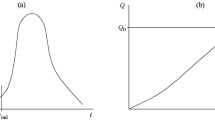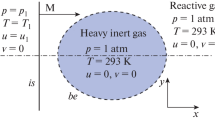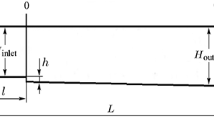Abstract
The problem of spontaneous combustion of a compressible reacting gas in a wall boundary layer behind a single shock wave in a tube with an adiabatic wall is examined. The possibility of leading spontaneous combustion of the gas in the boundary layer compared with spontaneous combustion in the flow core is shown in an approximation of a one-stage chemical reaction. Explosion in the boundary layer occurs locally, and in the vicinity of the exploding gas particle there is a finite gradient of the spontaneous-combustion induction time. The calculated velocity of the spontaneous-combustion (spontaneous-flame) wave is close to the local sound velocity, which indicates the possibility of the generation of a strong blast wave. With consideration of the nonadiabatic character of the wall, the investigated effect is manifested as a result of multiple compression of the reacting mixture by shock waves or simple compression waves, as well as for a wall made of a material with a low thermal conductivity.
Similar content being viewed by others
References
Ya. B. Zel'dovich and A. S. Kompaneets, Detonation Theory [in Russian], Gostekhteoretizdat, Moscow (1955).
G. Emmons (editor), Principles of Gas Dynamics [Russian translation], Izd. Inostr. Lit., Moscow (1963).
C. O. Lee and M. Sichel, “An investigation of the steady flame propagation in a duct,” in: Proc. Meeting of the Eastern Section of the Combustion Institute, Orlando, Florida, Dec. 3–5, 1990.
J. W. Meyer, P. A. Urtiew, and A. K. Oppenheim, “On the inadequacy of gasdynamic processes for triggering the transition to detonation”, Combust. Flame,14, No. 1, 13–20 (1970).
P. Wolanski, “Influence of nonisentropic processes on transition from deflagration to detonation in combustion mixtures,” Arch. Combustionis,11, No. 3-4, 143–149 (1991).
V. K. Koshkin (editor), Principles of Heat Transfer in Aerospace Engineering [in Russian], Mashinostroenie, Moscow (1975).
H. Schlichting, Boundary-Layer Theory [Russian translation], Nauka, Moscow (1974).
L. G. Loitsyanskii, Laminar Boundary Layer [in Russian], Fizmatgiz, Moscow (1962).
Ya. B. Zeldovich, “Regime classification of an exothermic reaction with nonuniform initial conditions,” Combust. Flame,39, No. 2, 211–214 (1980).
S. M. Frolov, B. E. Gel'fand, and S. A. Tsyganov, “Spontaneous combustion regimes,” Fiz. Goreniya Vzryva,29, No. 1, pp. 111–123, 1993.
G. Merles, “Boundary layer on a wall behind a moving shock wave,” in:Shock Tubes: Collection of Articles [Russian translation], Moscow (1962), pp. 320–331.
A. Chabai and R. Emrich, “Measurement of the temperature of the wall and heat flow in a shock tube,” ibid. in:Shock Tubes: Collection of Articles [Russian translation], Moscow (1962), pp. 617–618.
J. Rabinovicz, M. E. Jessey, and C. A. Bartsch, “Resistance thermometer for transient high-temperature studies,” J. Appl. Phys.,27, No. 1, 97–98, 1956.
Additional information
N. N. Semenov Institute of Chemical Physics, Russian Academy of Sciences, Moscow. Translated from Fizika Goreniya i Vzryva, Vol. 31, No. 3, pp. 29–36, May–June, 1995.
Rights and permissions
About this article
Cite this article
Noskov, M.A., Wolanski, P. & Frolov, S.M. Effect of nonisentropic processes on transition from combustion to detonation in combustible mixtures. Combust Explos Shock Waves 31, 297–303 (1995). https://doi.org/10.1007/BF00742674
Received:
Revised:
Issue Date:
DOI: https://doi.org/10.1007/BF00742674




